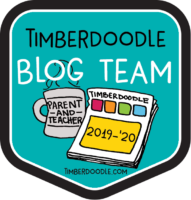Kids can learn anywhere, but that doesn’t mean you don’t need an organized space dedicated to the hard work of learning. Homeschool spaces look different in every home and family. But there are a few common threads you can see within the beauty of variation..
The Essential Needs of Every Homeschool Space
Book Shelves
Even unschoolers, who may see no need for a dedicated schoolroom, still have shelves full of books. These might show up in one central location, but it is more likely that they are scattered throughout the house. Every homeschool needs books, and the more places books are temptingly scattered about, the more likely a kid is to pick up a book to read in their free time.
Other Shelves
You may also need other shelves to store games, science kits, or other hands-on activities. We put our games on garage shelving, in the garage, because we don’t have any good closets or cubbies in the house that can handle our game storage needs. We keep the puzzles here too.
A Table or Desk
There will be times when working at a table or on a desk help make the learning task more efficient. You need flat spaces, whether or not your kid uses them the entire day, or just for handwriting.
A table or desk also creates a certain trigger in a childs brain. It is the physical space for doing intellectual work and just sitting down in this space can help bring a fuzzy brain into attention mode.
Some homeschoolers use traditional school desks, others use office desks, some buy a folding table, and others just use the dining room or kitchen table. What you use depends on what fits in your space, what you have, and what your budget is.
I have 2 desks, a patio table, and a folding table in our school room, and an old kitchen table in the basement, where the two older teens do most of their school work. It’s a hodgepodge, because I am just a hodgepodge sort of person. Anything that is inexpensive and will do the job works for me.
Tables, Couches, and Beds, Oh My!
Learning is expansive and your kids will probably not stay in your carefully curated homeschool room all day long. Certainly not as they get older. We have one rule in our house. If you are doing what your are supposed to be doing, and doing it to the best of your abilities, then you can do it wherever you like.
This rule helps kids find their own best learning spaces while also holding them accountable. Maybe they need to get away from siblings, or maybe they work the best in the middle of noise. Maybe they are just agitated at a brother and need to get away for awhile. Maybe they don’t want anyone else to see their emotional struggle with today’s math problem.
They might need to get outside, the outdoors is a soothing environment to our senses and can quickly bring a dose of calm to mind that is fatigued from all the stretching and growing it has been doing.
Children who are raised to love learning take their learning wherever they go.
Sure, they sit at a table when they need a hard surface to work on.
But they might take their math to their bedroom if they need quiet (there are six kids, two dogs, a cat, and a bird in our house…not much quiet).
Or they might find the perfect space under their desk.
Of course, if we are reading aloud, we will either be scrawled throughout the living room, on couches or the floor, lounging on the dogs (don’t worry, they are big and can handle cuddles quite well). We do lots of learning with read-alouds, from literature, to history, to high school economics.
Unless the kids are eating or feeling artsy, then we move to the kitchen table while I read.
Don’t forget the hammocks, a little fresh air and bird chatter might be just what the soul craves while hitting the books.
When They Are Little
One of things that young children are learning is the art of how to learn. Teaching them the habits of paying attention, thinking, and getting into the mindset of learning each day can be easier when we use the trigger of a specific environment as the place where all that hard brain stretching happens.
To be honest, where we did homeschool mattered a lot more when the kids were little. It was easier for me to train them in the art of concentration when they were all nearby. My youngest two still do most things within eyesight of mom, because I don’t trust them yet. I do let them move to a different room when they say another person’s noisy work is distracting them. That is when they can practice working without mom watching. But if they are not focusing on their work, they have to come right back to the chair next to me.
But as they get older, they wander and I let them, as long as they are getting their work done. If I check on their work and it isn’t getting done, I reel them back into whatever space I am occupying. The closer they are to mom, the easier it is for them to do what they are supposed to be doing.
All the same, before they leave my house they need to know how to do what they need to do without mom staring them down.
As kids get older they gain a mastery over the skill of learning. They know how to pay attention, stretch their brain, and think. As these skills become easier they may not be as reliant on a specific environment to trigger these behaviors. Although it can still help get their brain in learning mode on a tough day. Teens are also finding out more about themselves and what kind of environment helps them learn and think best. They can only really figure this out when they have some freedom to move around, try out things that don’t work, and noticing the things that make focusing easier.
Do You Need an Office/Schoolroom?
I find it necessary to have a dedicated space for academic work, even if we are not dedicated to that space. (However, it does not have to be an entire room.) We keep current work and books in the room, timelines and maps on the wall, pencils, paper, and notebooks are all easily accessible. (Actually, there are maps on the living room wall too now, that just makes it easier to spot locations as we watch documentaries.)
We often have a large table in the middle of the room. A computer on a table or desk in the corner. If there is room, there may be another table or a few small desks in the room.
Right now, this room is the one in our house designed as a dining room. We don’t use it that way because there are other places to eat in our house that make more sense. A long time ago, we lived in a much smaller house, and in that house the dining room was both the dedicated eating space and the designated learning space. We put short bookshelves against along one wall to house the schoolwork and hung a chalkboard and whiteboard above the shelves.
The size of your house does not matter. Whether the room is multi-purpose or singularly focused does not matter. What matters is that your homeschool materials have a place that they belong, and they are easy to access.
Homeschool Spaces are About Giving the Hard Work of Learning a Helping Hand
These are the places and spaces where we live and learn. Where we ‘do school’ is inconsequential. We do it in the best and easiest spot for any given child and subject on any particular day.
We keep workbaskets or shelves for each child near whatever area they are the most likely to use. We tape schedules to the wall, shelf, or desk near that area. We call that place an office or schoolroom, but it is only one of the many spaces in our home that gets used every day for the important work of learning.
As you work on designing or tweaking your homeschool space for the upcoming school year, I encourage you to keep in mind the ultimate purpose of the space. All you need is a space where your child and you are both comfortable, an empty flat surface, and all the supplies they need nearby.



2 Responses
[…] The Places & Spaces Where We Learn […]
[…] The Places & Spaces Where We Learn […]